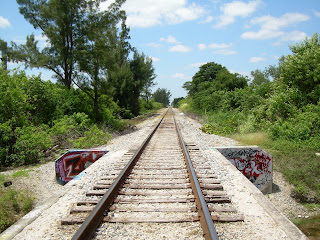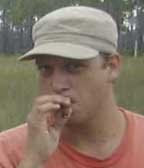
What the heck is this doing here? A critically imperiled ecosystem, grasping this linear tract of land that runs for miles between the tracks and the neighboring houses and expressways. Pine rockland, a habitat restricted to South Florida and the Bahamas, less than 1.5% left in Dade County (excluding the glades, which have another 11%).
A native woodland, dependant on fire for its survival, is dominated by the once prized Dade County pine (Pinus elliottii var. densa) whose valuable wood was over harvested for building, being known for its termite resistance. Below the pines, almost endemic to Florida are two undervalued palms. Florida's state tree, the Cabbage palm (Sabal palmetto), whose hearts were once used (and still used in some areas) as a food source by early peoples; it is our state tree. Along with, is the red-headed stepchild of Florida palms, the Saw palmetto (Serenoa repens), a fascinating palm whose habitats are rapidly declining, possessing trunks that radiate from the center along the forest floor appearing as a wagon wheel on its side.
Native grasses abound. Many have just started flowering, acting as a harbinger for the upcoming fall. Bluestems (Schizachyrium spp.), Broomsedges (Andropogon spp.), Muhly grass (Muhlenbergia capillaris), and one of my favorites, Lopsided Indiangrass (Sorghastrum secundum), all showing off their temporary inflorescences (flower clusters) trying to cast & catch pollen in the wind.
Amid the grasses, colorful wildflowers make certain of their appearance. The scorpiontail shaped yellow inflorescences of Pineland heliotrope (Heliotropium polyphyllum) are scattered among the grasses to the delight of the bees and wasps. Along with other insects, they are grateful for this track side smorgasbord that allows them to live and eat, providing a safe place to travel to the other islands in the stream. Dancing amongst the heliotropes, Painted leaf (Poinsettia cyathophora) with its fiddle shaped leaves and striking red colored bracts reminescent of Christmas. Twining around the shrubs and palms are two vines in the Dogbane family (Apocynaceae). Calling forth are the yellow trumpets of Pineland allamanda (Angadenia berteroi) and the white pinwheels of Devil's potato (Echites umbellata). Tall flowering stalks of Wand goldenrod (Solidago stricta), conduct their magic waving in the wind. Many, many more occur along this echo of a better vanished time; I counted over seventy species.
I smile, the heart pumps in exhilaration. These guys are still hanging on, despite no help from others. Across the fence along the expressway, the story was similar. But progress mandated that the wildflowers amidst the sod be removed, and a tall concrete barrier be put in place. New sod will surely be planted, only, it won't contain any of these jewels. I think to myself, maybe our railroad friends will hop the fence, and give that sod a run for its money.
No, the railroad company doesn't manage for these plants, at least, not intentionally. I am certain an occasional spark from a train rumbling on down the tracks creates nice, slow-burning little fires, which undoubtedly are extinguished all too soon. I am thankful for the railroad company's frugality, as I am sure they don't wish to spend a lot of money altering this patch of Eden, unlike too many government agencies who should know better.
I have visited it only once, but this place is already sacred to me. I am not alone, others visit all along these 4 miles of tracks, I have seen evidence since I started my journey from the shop. Scattered everywhere are chicken bones, there is the occasional wooden carving or carefully created altar....it appears that Chango' must live here too. (Railroad 3of 5)
A native woodland, dependant on fire for its survival, is dominated by the once prized Dade County pine (Pinus elliottii var. densa) whose valuable wood was over harvested for building, being known for its termite resistance. Below the pines, almost endemic to Florida are two undervalued palms. Florida's state tree, the Cabbage palm (Sabal palmetto), whose hearts were once used (and still used in some areas) as a food source by early peoples; it is our state tree. Along with, is the red-headed stepchild of Florida palms, the Saw palmetto (Serenoa repens), a fascinating palm whose habitats are rapidly declining, possessing trunks that radiate from the center along the forest floor appearing as a wagon wheel on its side.
Native grasses abound. Many have just started flowering, acting as a harbinger for the upcoming fall. Bluestems (Schizachyrium spp.), Broomsedges (Andropogon spp.), Muhly grass (Muhlenbergia capillaris), and one of my favorites, Lopsided Indiangrass (Sorghastrum secundum), all showing off their temporary inflorescences (flower clusters) trying to cast & catch pollen in the wind.
Amid the grasses, colorful wildflowers make certain of their appearance. The scorpiontail shaped yellow inflorescences of Pineland heliotrope (Heliotropium polyphyllum) are scattered among the grasses to the delight of the bees and wasps. Along with other insects, they are grateful for this track side smorgasbord that allows them to live and eat, providing a safe place to travel to the other islands in the stream. Dancing amongst the heliotropes, Painted leaf (Poinsettia cyathophora) with its fiddle shaped leaves and striking red colored bracts reminescent of Christmas. Twining around the shrubs and palms are two vines in the Dogbane family (Apocynaceae). Calling forth are the yellow trumpets of Pineland allamanda (Angadenia berteroi) and the white pinwheels of Devil's potato (Echites umbellata). Tall flowering stalks of Wand goldenrod (Solidago stricta), conduct their magic waving in the wind. Many, many more occur along this echo of a better vanished time; I counted over seventy species.
I smile, the heart pumps in exhilaration. These guys are still hanging on, despite no help from others. Across the fence along the expressway, the story was similar. But progress mandated that the wildflowers amidst the sod be removed, and a tall concrete barrier be put in place. New sod will surely be planted, only, it won't contain any of these jewels. I think to myself, maybe our railroad friends will hop the fence, and give that sod a run for its money.
No, the railroad company doesn't manage for these plants, at least, not intentionally. I am certain an occasional spark from a train rumbling on down the tracks creates nice, slow-burning little fires, which undoubtedly are extinguished all too soon. I am thankful for the railroad company's frugality, as I am sure they don't wish to spend a lot of money altering this patch of Eden, unlike too many government agencies who should know better.
I have visited it only once, but this place is already sacred to me. I am not alone, others visit all along these 4 miles of tracks, I have seen evidence since I started my journey from the shop. Scattered everywhere are chicken bones, there is the occasional wooden carving or carefully created altar....it appears that Chango' must live here too. (Railroad 3of 5)


